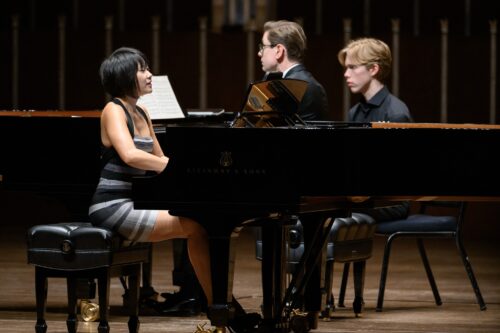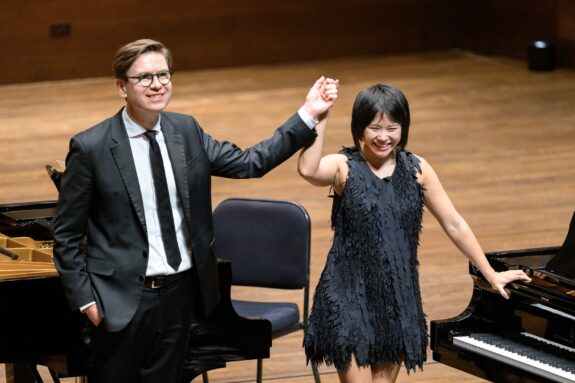 United States Various: Yuja Wang, Víkingur Ólafsson (pianos). Mandel Concert Hall at Severance Music Center, Cleveland, 23.2.2025. (MSJ)
United States Various: Yuja Wang, Víkingur Ólafsson (pianos). Mandel Concert Hall at Severance Music Center, Cleveland, 23.2.2025. (MSJ)

Berio – ‘Wasserklavier’ from Six Encores for Piano
Schubert – Fantasie in F minor, D.940
Cage – Experiences No.1
Nancarrow – Study No.6 (arr. Thomas Adès)
Adams – Hallelujah Junction
Pärt – Hymn to a Great City
Rachmaninov – Symphonic Dances
Encores:
Brahms – Waltz in E major, Op.39 No.2; Waltz in G-sharp minor, Op.39 No.3; Waltz in A-flat major, Op.39 No.15; Hungarian Dance No.1 in G minor
Dvořák – Slavonic Dance in E minor, Op.72 No.2
They seem an unlikely pair on paper, Yuja Wang and Víkingur Ólafsson, but in practice the two superstar pianists made a fascinatingly contrasting and complementing duo in this recital in Cleveland. While both artists have tremendous ranges and both played with considerable subtlety and nuance, the simplified essence of their work was that Ólafsson provided the architectural framework of the pieces, and Wang was the free agent of chaos testing those boundaries.
Perhaps the most intriguing part of the concert was Schubert’s Fantasie in F minor. Neither pianist is much associated with this composer: Wang is known for scintillating encounters with high romantic composers like Rachmaninov, while Ólafsson is known for exploring early and modern keyboard music. But that let them approach Schubert with a freshness that kept it very much in the moment. Ólafsson provided the landscape and Wang the lightning, with the fleeting breaks between themes handled as moments of tense expectation.
It was particularly fascinating to have the chance to compare the two pianists superimposed. The duo setup was unusual, with the pianos not placed in the traditional interlocking position but instead pointing outwards, so that the two pianists were sitting side by side on their separate benches, facing in opposite directions. This helped separate their sounds, which were already distinctive: Wang’s is bright and mercurial, while Ólafsson’s is darker and more sustained. In places, each pianist altered the tone as the two passed ideas back and forth, making the music quite literally the bridge between them.
Rachmaninov’s own two-piano arrangement of his Symphonic Dances was intense and brilliant, and the chance to hear it on keyboards was welcome for its ability to clarify some of the composer’s more harmonically dense passages. The high virtuoso approach was arguably more dazzling than haunting, with its nervously fast tempos, and it in no way supplants the full orchestral version, heard just a few months ago here in a downright apocalyptic performance by Elim Chan and the Cleveland Orchestra. But the chance to hear this version so soon after was a delight, and it brought a roaring ovation at the end of the concert.
Most exciting of all was the closer of the first half, Hallelujah Junction by John Adams, a composer both pianists have performed extensively. The piece takes its name from a truck stop near Adams’s home in California, and the kinetic energy of the road is writ large in it. The pianists grooved, even stomped, to frenetic riffs, sometimes interlocking, sometimes clashing in a keyboard version of road rage. The third movement, in particular, sounded like a player piano having a nervous breakdown. Wang and Ólafsson brought it off with exhilarating energy.
Each large work was introduced with modern pieces as preludes without pause, a wonderful practice. The Schubert was brought in by the spare, poignant ‘Wasserklavier’ by Luciano Berio, the Adams by a brilliant arrangement by Thomas Adès (just heard here conducting the Cleveland Orchestra) of Conlon Nancarrow’s player-piano Study No.6. Exactly how Adès notated Nancarrow’s drily witty layers moving at different speeds would be interesting to see, but it made a glorious opportunity to reintroduce a major composer whose work is rarely heard live in concert, simply because humans usually cannot play it. Indeed, humans may never be able to play the faster, more complex studies, but this one, with its jazzy blue notes and raised-eyebrow wit, was a triumph. Less compelling was Arvo Pärt’s Hymn to a Great City, a fairly bland example of that composer’s tintinnabulation style of bell-like notes, but it did serve well gesturally to open for the Rachmaninov, which also starts with repeated notes.
Standing as a solitary centerpiece among these preludes and peaks was John Cage’s Experiences No.1, which made as much music out of the silences between sections as the gracefully arching phrases themselves. It was a typically smart choice for this thoughtfully built program which flattered both pianists but also made them a force in unison quite unlike anything each could achieve alone. That is a strong force, and let us hope this isn’t the only time we get to hear them work together, especially as their encores, delivered from one shared piano, showed how adorable, charming and fun they could be after the heroics of the evening were done.
Mark Sebastian Jordan
Featured Image: Víkingur Ólaffson and Yuja Wang at Severance Music Center in Cleveland © Human Artist Photography/TCO

Thanks for the review. I was there, and try to see Yuja whenever (and wherever) possible. I loved the piano orientation, and (of course) the Severance Hall acoustics, which I have enjoyed for 75 years. Best, Bob.
Thanks, Bob! I hope she can make it back for the Tchaikovsky Concerto in a couple of weeks – I saw that she had to cancel one of her later shows with Ólafsson. But, with luck, she’ll be on the mend quickly and ready to pounce on the Tchaikovsky.